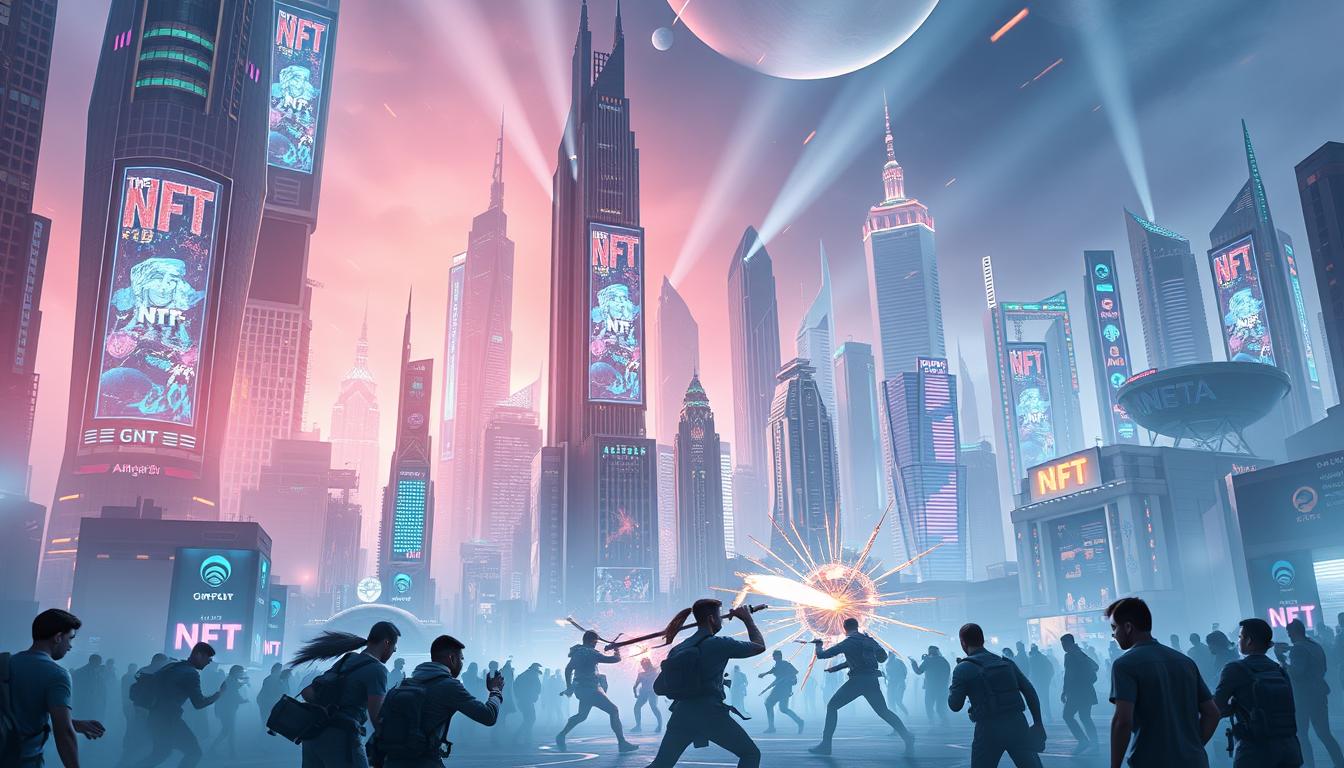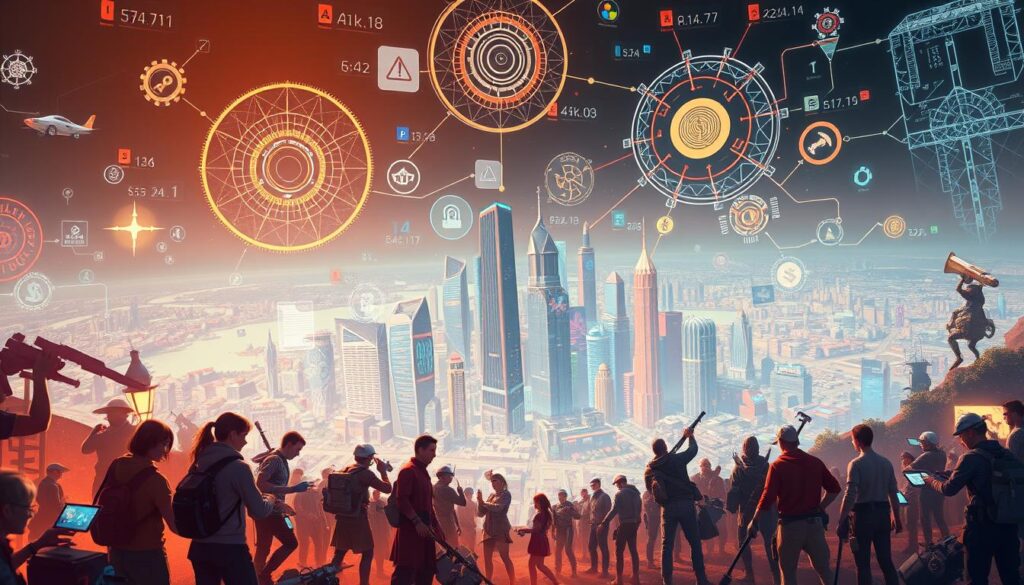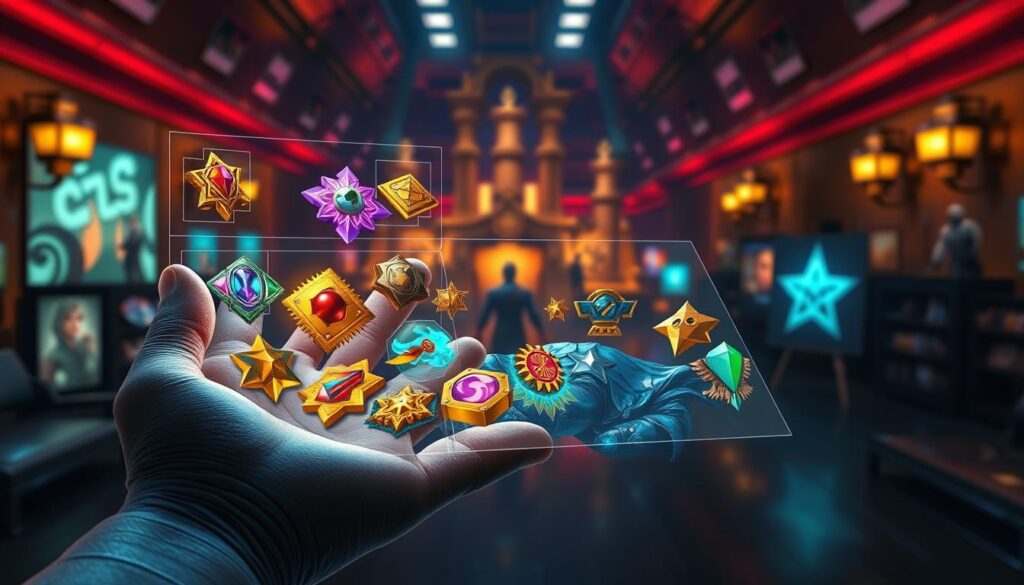Now Reading: Learn About NFT Gaming Play to Earn Models
- 01
Learn About NFT Gaming Play to Earn Models
Learn About NFT Gaming Play to Earn Models

The digital entertainment landscape is undergoing a remarkable transformation. Traditional video game experiences are evolving into immersive economies where participants can generate real value from their virtual activities.
This innovative approach combines entertainment with financial opportunities through blockchain technology. Players now have the chance to own digital assets that hold genuine monetary worth beyond the game environment.
The concept represents a fundamental shift in how we perceive interactive entertainment. Instead of simply consuming content, enthusiasts become active participants in thriving digital marketplaces.
This comprehensive guide explores how these new economic models function. We’ll examine the mechanics that allow dedicated participants to transform their skills and time into tangible rewards through strategic engagement with virtual worlds.
Key Takeaways
- Digital entertainment is evolving into interactive economies with real financial value
- Blockchain technology enables true ownership of virtual assets
- Participants can generate income through strategic gameplay and asset management
- These models represent a paradigm shift from traditional gaming approaches
- Understanding the mechanics is essential for maximising earning potential
- Proper risk management strategies are crucial in this emerging sector
Introduction to NFT Gaming Play to Earn Models
Virtual environments have evolved beyond entertainment into fully-functional economic ecosystems. These digital worlds combine engaging experiences with financial mechanics that reward active participation.
The fundamental shift involves moving from consumption-based models to participation-driven economies. Instead of spending money with no return, enthusiasts can now generate value through their virtual activities.
Overview of the Play-to-Earn Concept
This innovative approach represents a complete departure from traditional gaming economics. Participants receive cryptocurrency or other digital assets for completing in-game objectives.
Activities like quest completion, item trading, and tournament participation generate tangible rewards. The system creates transparent economic structures using blockchain technology.
True ownership becomes possible through tokenised assets that hold real-world value. These assets can be traded on external markets, providing financial flexibility.
| Feature | Traditional Models | Play-to-Earn Systems |
|---|---|---|
| Financial Return | No monetary value | Real-world earnings |
| Asset Ownership | Licensed access only | Full ownership rights |
| Economic Participation | Consumer role | Active contributor |
| Reward Structure | Cosmetic items | Tradable assets |
The Rise of NFT Games
The sector has experienced remarkable growth, generating over $470 billion in 2024. Projections indicate this could exceed $940 billion by 2029.
Millions of participants worldwide engage with these virtual economies. The combination of entertainment and earning potential attracts diverse audiences.
Mainstream attention continues growing as blockchain technology becomes more accessible. This expansion brings new opportunities for virtual investment and asset collection.
Understanding the NFT Gaming Landscape
Modern game development embraces distributed ledger technology to create player-owned economies. This shift empowers participants with genuine ownership of virtual possessions.
Blockchain Technology Trends
Multiple distributed ledger systems support these interactive experiences. Each platform offers distinct advantages for different types of games.
Ethereum provides robust security but sometimes faces congestion issues. Binance Smart Chain offers faster transactions with lower costs. Ronin specialises in gaming applications with optimised performance.
| Platform | Transaction Speed | Cost Efficiency | Specialisation |
|---|---|---|---|
| Ethereum | Moderate | Variable | Established ecosystem |
| Binance Smart Chain | Fast | High | Cost-effective transactions |
| Ronin | Very Fast | Excellent | Gaming optimisation |
| Hive | Fast | High | Social applications |
Layer 2 solutions enhance scalability while reducing environmental impact. Cross-chain interoperability allows assets to move between networks seamlessly.
Smart contracts automate reward distribution and trading mechanics. This creates trustless systems where participants transact directly.
Understanding these technological foundations helps enthusiasts choose suitable platforms. The right selection maximises both enjoyment and potential returns.
Exploring NFT Gaming Play to Earn Mechanics
The mechanics underpinning player-owned economies represent a fundamental shift in digital interaction. These systems utilise distributed ledger technology to create transparent relationships between participants and virtual worlds.
On-chain transactions form the backbone of these innovative systems. Every asset transfer and reward distribution becomes permanently recorded on the blockchain.
How On-Chain Transactions Empower Players
Transparent record-keeping gives participants unprecedented control over their digital possessions. They can verify ownership history and transaction authenticity at any time.
Reward distribution follows diverse models across different platforms. Some systems emphasise individual achievement while others focus on community sharing.
True ownership becomes possible through tokenised assets that participants control completely. These items can be traded freely across marketplaces without restrictions.
Smart contracts automate reward distribution based on predefined rules. This ensures immediate payment for completed activities like quests or battles.
The variety of risk levels allows everyone to find suitable engagement styles. From casual participation to competitive tournaments, the mechanics accommodate different preferences.
Differences Between Free-to-Play and Play-to-Earn Models
Contemporary digital worlds present users with fundamentally different participation frameworks. These models shape how enthusiasts interact with virtual environments and what benefits they can expect from their engagement.
Rewards and Incentives
Free-to-play options allow enthusiasts to participate without initial purchases. They typically function as entertainment experiences rather than income-generating opportunities.
These platforms prioritise accessibility and player acquisition. Anyone can experience the virtual world without financial barriers.
In contrast, play-to-earn systems reward participants with crypto tokens for their efforts. This creates economic incentives that transform leisure activities into potential income streams.
Most play-to-earn modes require purchasing digital assets to participate. This represents an initial investment that can generate returns through gameplay rewards.
The rewards in these systems generally derive from revenue generated through in-game transactions. This creates a sustainable economic model that benefits active participants.
Some platforms combine both approaches, offering basic free access with optional premium features. This flexibility accommodates different engagement styles and financial commitments.
Ownership, Security and Verification of In-Game Assets
Players now enjoy unprecedented control over their virtual collections thanks to cryptographic verification systems. Traditional models limited enthusiasts to temporary access rather than genuine possession of their digital items.
Blockchain technology revolutionises this dynamic by enabling true ownership through unique digital certificates. Each asset receives a distinct cryptographic signature that cannot be replicated or forged.
Smart contracts automatically verify transaction details before processing any exchange. This system examines ownership records, item values, and transfer history for complete transparency.
| Aspect | Traditional Systems | Blockchain Solutions |
|---|---|---|
| Ownership Type | Licensed Access | Full Property Rights |
| Security Level | Centralised Protection | Decentralised Verification |
| Transaction Speed | Variable Processing | Immediate Settlement |
| Fraud Prevention | Limited Safeguards | Cryptographic Assurance |
| Asset Transfer | Platform-Restricted | Cross-Game Compatibility |
This verification framework eliminates risks associated with counterfeit items or misrepresented assets. Enthusiasts can confidently engage in trading activities knowing each transaction undergoes rigorous validation.
The combination of ownership rights and security measures creates a trustworthy environment for digital asset management. Participants benefit from both financial opportunities and creative control over their virtual possessions.
Blockchain Integration and In-Game Transactions
Seamless digital commerce forms the foundation of successful virtual economies. The integration of distributed ledger systems revolutionises how participants exchange digital possessions.

This technology enables direct peer-to-peer exchanges without intermediaries. The result is faster processing and reduced costs for all participants.
Smart Contracts and Speed
Automated agreements execute transactions when specific conditions are met. This eliminates manual processing delays and ensures immediate rewards.
Different platforms offer varying performance characteristics. Ethereum provides robust security, while alternatives like Binance Smart Chain and Ronin offer optimised speed for interactive experiences.
Secure Asset Trading
Cryptographic validation protects every exchange between participants. Network consensus prevents fraudulent activities and unauthorised alterations.
Professional payment solutions add additional security layers. These systems implement authentication protocols and fraud detection mechanisms.
Transaction fees vary across different distributed ledger systems. Some platforms charge minimal costs, while others have substantial fees during peak usage periods.
The transparency of this technology allows independent verification of all activities. Participants can audit transactions without relying on central authorities.
Tokenised Assets and In-Game Currencies
Digital economies within interactive platforms are revolutionising how participants engage with virtual assets. These systems convert characters, items, land, and currency into blockchain-based tokens that provide genuine ownership rights.
Participants store these digital possessions in their personal wallets, allowing cross-platform usage. This interoperability creates connected experiences across multiple virtual worlds.
Governance Tokens Explained
Most platforms implement dual-token economies with distinct functions. The first token serves as an in-game currency for activities like upgrading gear and purchasing items.
The second token type provides governance rights to stakeholders. Holders can vote on development proposals and economic adjustments within the platform’s ecosystem.
This separation maintains stable in-game economies while giving long-term participants influence over strategic direction. The value of functional tokens fluctuates based on supply, demand, and platform popularity.
Certain in-game currencies can be traded on external exchanges. This allows participants to convert virtual earnings into other cryptocurrencies or traditional funds for real-world use.
Benefits of Decentralised Game Economies
Decentralised economies represent a significant advancement in how virtual worlds operate. These systems remove central authorities from economic transactions, giving participants direct control over their digital possessions.

Players can trade assets through peer-to-peer marketplaces without intermediary restrictions. This creates vibrant ecosystems where community demand determines item values rather than developer pricing.
The system provides true economic agency to participants. They become investors, creators, and entrepreneurs within the game economy.
Several mechanisms enhance engagement in these environments:
- Staking systems reward long-term participation with additional benefits
- Governance rights allow dedicated players to influence development decisions
- Cross-platform compatibility enables asset transfer between different experiences
This approach reduces risks associated with arbitrary rule changes from central companies. The community collectively governs economic parameters through transparent processes.
Player-driven economies naturally encourage content creation and innovation. Financial incentives motivate participants to develop valuable items and experiences that benefit everyone.
Third-party developers can build complementary tools without seeking permission. This organic growth strengthens the entire ecosystem beyond what any single company could achieve.
Evaluating Earning Potential in NFT Games
Participants can explore multiple pathways to financial returns within token-based virtual worlds. Each method offers distinct advantages depending on individual preferences and risk tolerance.
Understanding these options helps enthusiasts make informed decisions about their engagement strategies. The right approach depends on available time, initial investment, and personal interests.
Direct Play Earnings Versus Trading Profit
Active participation provides the most straightforward method for generating earnings. Players complete quests and win competitions to receive digital rewards.
This approach requires minimal financial risk while offering consistent returns. Many enthusiasts find this method enjoyable alongside its financial benefits.
Marketplace activities present alternative opportunities for substantial profits. Strategic acquisition and enhancement of digital assets can yield significant returns.
Successful trading demands careful analysis of market trends and asset valuation. This method typically requires greater expertise and capital investment.
Rental models create passive income streams for asset owners. Valuable digital items can generate continuous earnings without active gameplay involvement.
The most effective strategies often combine multiple approaches. Diversification helps maximise overall returns while managing risk exposure.
Case Studies from Leading NFT Gaming Platforms
Leading platforms demonstrate practical applications of token-based economies across diverse gaming genres. These examples show how successful integration of blockchain technology creates sustainable models.

Axie Infinity Insights
Axie Infinity stands as a pioneering example in the creature collection genre. Participants collect, breed, and battle with digital creatures called Axies.
The platform utilises a dual-token system with AXS for governance and SLP for breeding activities. This creates continuous demand through core gameplay mechanics.
According to DappRadar, the platform has generated substantial economic activity exceeding $4.28 billion.
Illuvium and Splinterlands Overview
Illuvium offers an open-world RPG experience where participants collect Illuvial creatures. These digital assets serve both combat and trading purposes within the Ethereum ecosystem.
Splinterlands presents a strategic card battle game attracting over 1.5 million participants. Players build decks using tradeable digital cards with unique abilities.
Both platforms demonstrate how traditional game mechanics successfully integrate blockchain technology. Gods Unchained follows similar principles in the tactical card game space.
These case studies reveal common success factors including balanced token economics and engaging core gameplay. Community engagement remains essential for sustainable growth.
Future Trends in NFT Gaming
Emerging technologies are reshaping how enthusiasts interact with digital collectibles across multiple platforms. The landscape continues to evolve with innovations that promise more seamless experiences.
Mobile Integration and AR/VR Impact
Cross-platform functionality represents a major advancement for participants. Games are becoming accessible across PC, iOS, and Android devices.
This expansion dramatically increases potential audiences beyond desktop-only users. Players can maintain their progress and collections across different devices seamlessly.
Augmented and Virtual Reality technologies add immersive layers to digital experiences. These innovations create spatial environments where users physically interact with virtual items.
| Feature | Current State | Future Development |
|---|---|---|
| Platform Access | Mostly desktop-based | Full cross-platform support |
| Asset Interoperability | Limited to single games | Multi-game utility |
| Immersive Technology | Basic implementations | Advanced AR/VR integration |
| Blockchain Connectivity | Network-specific assets | Cross-chain compatibility |
Blockchain improvements will enable smoother transitions between different networks. Users can move their crypto assets between various platforms without complex processes.
These developments create interconnected metaverse experiences. Digital possessions maintain utility and value across multiple virtual environments.
Tips for Maximising Your Earnings in Crypto Games
Strategic approaches can significantly enhance financial returns in blockchain-based entertainment experiences. Careful planning helps participants build sustainable income streams from their virtual activities.

Newcomers should avoid large initial investments. Starting with free options or small amounts allows exploration of mechanics and economic systems.
Platform Selection Strategies
Choosing the right environment is crucial for success. Participants should research each platform’s economy, token distribution, and marketplace liquidity.
Strong communities indicate healthy ecosystems. Checking social media channels reveals valuable insights about gameplay and earning potential.
Established developers with proven track records offer more stability. Their platforms typically maintain balanced economies and regular updates.
Risk Management Techniques
Diversification across multiple games reduces exposure to market volatility. Setting clear investment limits protects against significant losses.
Monitoring market conditions helps identify optimal buying and selling opportunities. Understanding multiple revenue streams within each game maximises overall returns.
For deeper insights into profitable strategies, explore these key approaches to boost your crypto game. Successful players balance time investment with realistic expectations about potential earnings.
Challenges and Risks in the NFT Gaming Ecosystem
While digital collectible platforms offer earning potential, they also introduce substantial risks that can impact returns. Participants face various obstacles that require careful navigation and risk management strategies.
The volatile nature of cryptocurrency markets directly affects the value of in-game rewards. Fluctuations in token prices can significantly alter the real-world value of player earnings.
Market Volatility
Market conditions create uncertainty for participants seeking consistent returns. The value of digital assets can change rapidly based on external economic factors.
Many platforms require substantial initial investments in virtual property or powerful items. This creates financial barriers for newcomers entering the space.
Complex mechanics around digital collectibles and blockchain technology present learning challenges. New participants may struggle to optimise their strategies without proper guidance.
Regulatory and Security Concerns
Legal frameworks surrounding digital assets remain uncertain across different regions. Regulatory changes could potentially restrict access or reduce asset values.
Security vulnerabilities pose ongoing threats to participant holdings. Smart contract exploits and phishing attacks can result in significant losses.
The emerging nature of these platforms means many lack established track records. Projects may fail to sustain participant interest or maintain functional economies over time.
Conclusion
A new era of participant-driven economies is emerging within virtual environments worldwide. These innovative platforms combine engaging experiences with genuine economic opportunities.
The true ownership of digital assets represents a fundamental shift in how enthusiasts interact with virtual worlds. This approach gives participants unprecedented control over their collections and rewards.
Successful engagement requires careful evaluation of platform economies and risk management strategies. Balancing the pursuit of financial returns with genuine enjoyment creates sustainable participation.
As technology evolves, these interactive experiences will likely integrate with broader metaverse concepts. The future promises more accessible and immersive opportunities for enthusiasts worldwide.
FAQ
What is a play-to-earn model in blockchain-based games?
A play-to-earn model allows participants to acquire valuable digital assets through gameplay. These items, like virtual land or unique cards, are secured on a distributed ledger. Players can truly own these assets and trade them for cryptocurrency or real money on various marketplaces.
How do I start earning with crypto games?
To begin, you typically need to purchase initial in-game items, such as characters or cards, to start playing. Games like Axie Infinity require this initial investment. Your earnings then come from winning battles, completing quests, or trading your acquired assets on secondary markets.
Are earnings from these games considered real income?
Yes, rewards earned can often be converted into real-world currency. The value of your earnings depends on the game’s economy and the market value of your assets, such as in-game tokens or rare items. It is important to be aware of potential tax implications on these profits.
What are the main risks involved in play-to-earn gaming?
Key risks include market volatility, where the value of your digital assets can fluctuate significantly. There are also security concerns, such as the safety of your cryptocurrency wallet, and the evolving regulatory landscape surrounding these digital economies.
Can I play these games on my mobile device?
Absolutely. Many leading platforms are developing mobile versions to increase accessibility. The integration of mobile gaming, along with emerging technologies like augmented reality, is a significant trend shaping the future of these virtual worlds.
What is the difference between free-to-play and play-to-earn models?
Free-to-play games often generate revenue through microtransactions without granting true ownership of items. In contrast, play-to-earn models use blockchain technology to give players verifiable ownership of their assets, which they can trade or sell, creating a potential revenue stream.
How does blockchain technology secure my in-game items?
Blockchain technology acts as a public, unchangeable ledger. When you own an asset, its record is stored on this ledger, providing proof of ownership. This prevents duplication and fraud, making the trading of items like those in Gods Unchained more secure.














